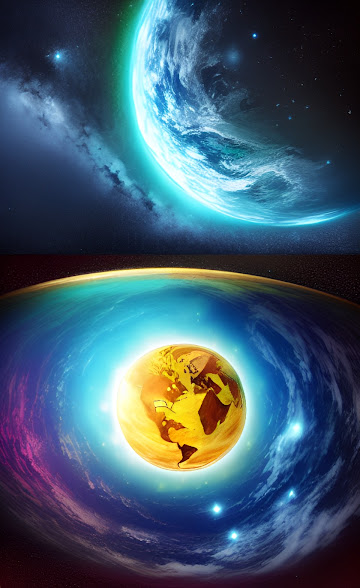ا Once upon a time, in the early 20th century, a brilliant physicist named Hugh Everett proposed a radical theory that shook the foundations of quantum mechanics. The theory was called the Many-Worlds Interpretation or MWI, and it posited that every time a quantum measurement is made, the universe splits into multiple parallel universes, each containing a different outcome of the measurement.
At first, the scientific community dismissed Everett's theory as absurd, but over time, more and more evidence has emerged to support it. The MWI has become one of the most fascinating and controversial ideas in modern physics, raising profound questions about the nature of reality, the role of consciousness, and the limits of scientific knowledge.
As the decades passed, physicists continued to study the implications of the MWI, and new discoveries only deepened the mystery. Some researchers proposed that the MWI could explain the existence of dark matter and dark energy, while others suggested that it could solve the famous "measurement problem" in quantum mechanics, which has baffled scientists for nearly a century.
Despite the many fascinating ideas and possibilities that the MWI has spawned, there are still many unanswered questions about this theory. Some physicists argue that it is untestable and therefore unscientific, while others maintain that it is the best explanation we have for the strange and mysterious world of quantum mechanics.
In the end, the debate over the MWI is far from settled, and it may remain one of the greatest mysteries of modern physics for generations to come. But for those who are willing to grapple with the complexity and wonder of the universe, the Many-Worlds Interpretation offers a tantalizing glimpse into the infinite possibilities of existence.
The Many-Worlds Interpretation proposes that every time a quantum event occurs, the universe splits into multiple parallel universes, each containing a different possible outcome of the event. For example, if a particle can be in two different states at the same time, according to quantum mechanics, in the MWI, the universe would split into two parallel universes, one in which the particle is in one state and another in which it is in the other state.
This theory has far-reaching implications for our understanding of reality. It suggests that there are an infinite number of parallel universes, each containing a different version of ourselves and our world. In one universe, we may have made a different decision, taken a different path in life, or even not existed at all.
The MWI has also been used to explain some of the most perplexing phenomena in physics, such as the apparent randomness of quantum events and the strange behavior of particles at the subatomic scale. It has been suggested that the MWI could provide a solution to the long-standing problem of quantum entanglement, in which particles become correlated in a way that cannot be explained by classical physics.
Despite its many fascinating possibilities, the Many-Worlds Interpretation remains a highly controversial theory. Some physicists argue that it is untestable and therefore unscientific, while others maintain that it is the best explanation we have for the mysteries of quantum mechanics.
As with any scientific theory, the MWI is subject to ongoing debate and revision as new evidence and perspectives emerge. But for those who are intrigued by the idea of infinite parallel universes and the endless possibilities of existence, the Many-Worlds Interpretation offers a fascinating and provocative glimpse into the nature of reality.
One of the most intriguing aspects of the Many-Worlds Interpretation is its implications for the concept of probability. In the MWI, every possible outcome of a quantum event is given equal weight, so the probability of any particular outcome is simply the fraction of parallel universes in which that outcome occurs.
This means that even highly unlikely events have a non-zero probability of occurring in the MWI. For example, there is a non-zero probability that you could flip a coin and get heads a million times in a row, simply because there are an infinite number of parallel universes in which that outcome occurs.
The MWI also raises questions about the role of consciousness in the universe. If every possible outcome of a quantum event exists in a parallel universe, does that mean that every possible version of ourselves also exists? And if so, what does that say about the nature of free will and personal identity?
Some physicists have suggested that the MWI could be used to explain the phenomenon of precognition, in which people claim to have had visions of future events. According to this idea, precognition could be explained by the fact that some individuals are somehow able to perceive events in parallel universes that have not yet occurred in our own universe.
Of course, these ideas are highly speculative and have yet to be rigorously tested or proven. Nevertheless, the Many-Worlds Interpretation remains one of the most fascinating and thought-provoking theories in modern physics, raising profound questions about the nature of reality, the limits of human knowledge, and the ultimate meaning of existence.
